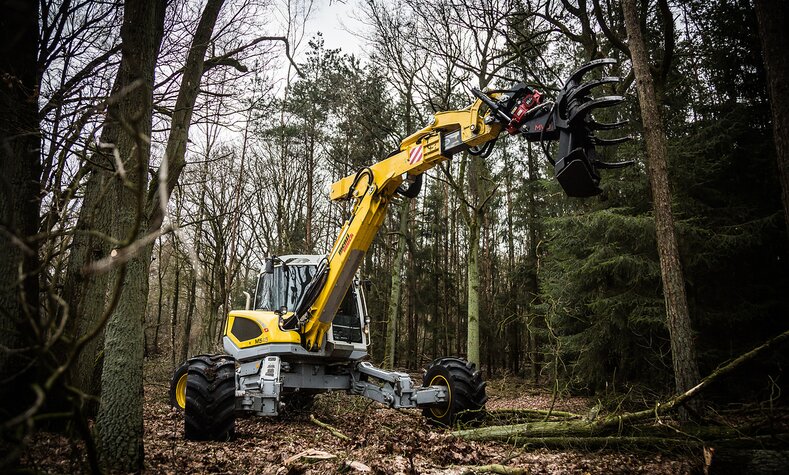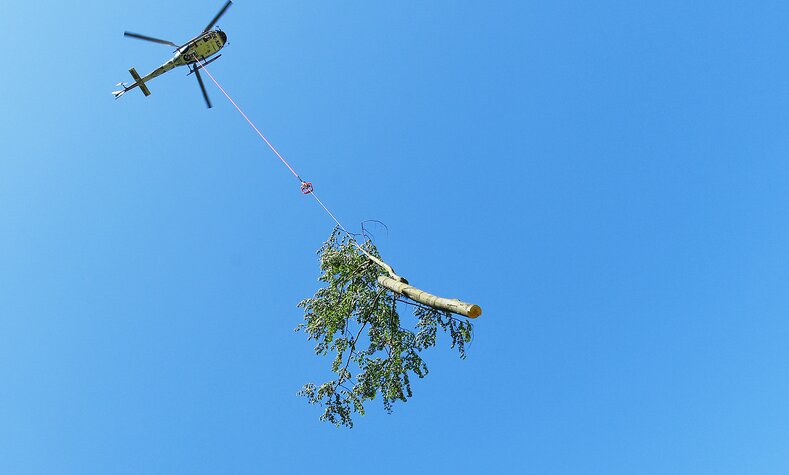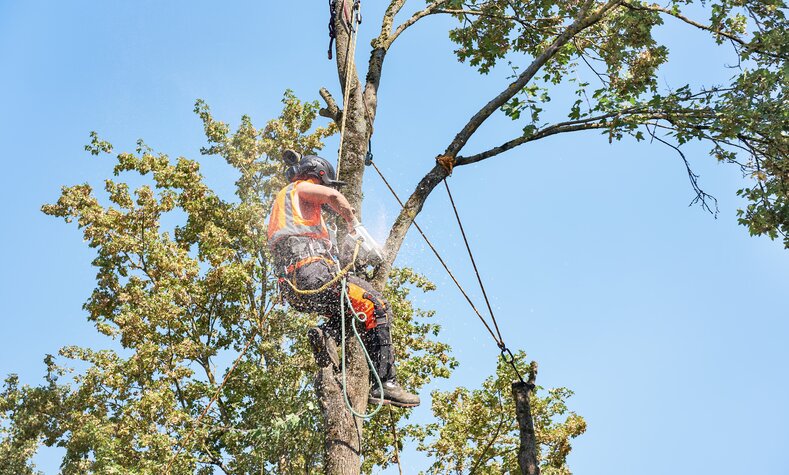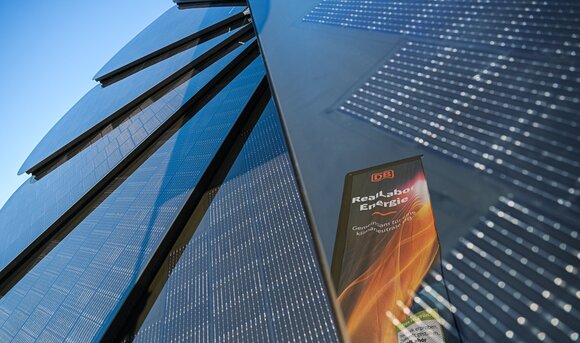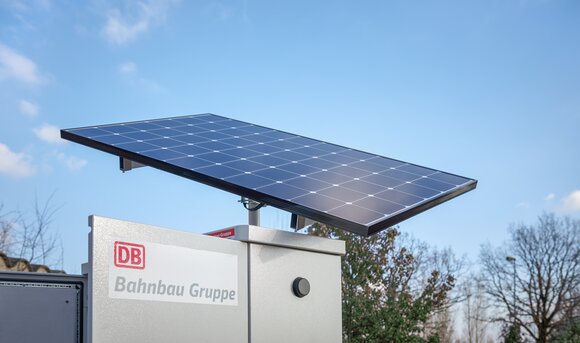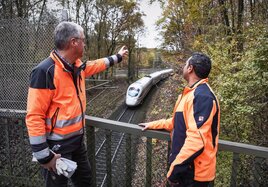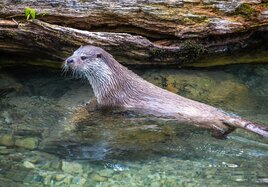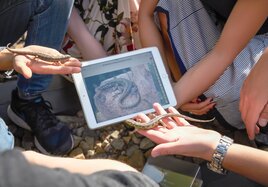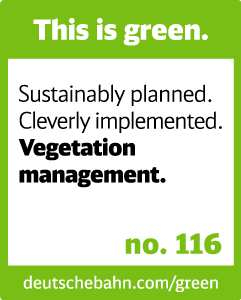
Deutsche Bahn's rail network covers about 33,000 kilometers. Many of the rail lines are situated next to forested areas. Endless trees, bushes and plants are at home here. In order to preserve this habitat, while at the same time ensuring that our trains can travel reliably and safely, we carry out sustainable vegetation management. This involves coordinating the interaction between various measures on and around the track.
glyphosate-free since 2023
One measure that we at Deutsche Bahn have implemented, for example, is completely dispensing with the use of glyphosate in Germany since 2023, as we had pledged. We are also driving forward alternative mechanical and digital processes.
Sustainably planned and implemented
The safety of our passengers is our top priority. That's why we make sure the trees and bushes along our lines are properly trimmed and do not encroach on the tracks or restrict the view of lineside signals. We cut back the vegetation six meters to the right and left of the tracks throughout the year. But we also keep an eye on the trees and plants beyond this pruning zone. If these are diseased, rotten or susceptible to storm damage, our vegetation experts cut them back, too, or remove them. We strictly observe the environmental and nature conservation authorities' specifications so as to avoid disturbing the breeding seasons of birds and mammals, for instance.
We usually shred the cuttings and return the rich biomass to nature. Usable wood is sold either whole or as wood chips. The remaining logs and branches are removed to a safe distance, where they provide a valuable habitat and shelter for smaller animals.
Innovative and digital forestry technology in use
Hundreds of track maintenance workers and foresters are employed by DB to inspect and maintain the forest areas near the rails. They receive additional support from space. We use satellite data to monitor the tree population throughout the year, processing it by means of artificial intelligence to create digital vegetation maps. This enables us to identify storm-susceptible trees more quickly and make the rail network even more robust and weatherproof.
We have the right technology for every application. From a spider excavator weighing 12 metric tons, which is particularly suitable for working on steep slopes and rough terrain, to helicopters and flying saws for aerial pruning and remote-controlled mulchers, our pool of tools and machines offers many clever solutions.
Innovative mix of measures for more sustainability
We also ensure that plants do not grow out of control on the tracks. If left, their roots tend to loosen the track bed and thus endanger its stability. At Deutsche Bahn, we have fulfilled our pledge and completely dispensed with the use of glyphosate in Germany since 2023. Sustainable vegetation management, therefore, involves coordinating the interaction between various measures.
One of the measures in the mix is the targeted use of chemicals in vegetation control. The use of pelargonic acid provides us with an ecological solution, as it is an active ingredient of natural origin. It is biodegradable and harmless to bees. Pelargonic acid acts only where it is applied. This means that the treated parts of plants die, while the roots remain intact. Pelargonic acid was approved for use by the competent authorities and in consultation with environmental associations in February 2023. By completely phasing out glyphosate in Germany in 2023, DB is sending a clear message in terms of environmental protection and nature conservation.
In addition to chemical vegetation control, we are increasingly choosing alternative methods. As well as the use of digital processes, these include technical advancements in mechanical and manual methods, such as semi-autonomous mowers. We frequently exchange ideas and experiences with other European rail companies. However, these innovative processes are not yet available for use in rail operations.
Semi-autonomous mower
This radio-controlled mowing vehicle is particularly narrow. Integrated sensors ensure that it always maintains a sufficient distance from the track. This means it can mow trackside walkways efficiently in particular.
Ballast brush
The ballast brush is a rotating brush that brushes and cleans the ballast in the track bed to reduce vegetation. It can be fixed as an attachment to various track work vehicles.
Electric Weeding
Electric weeding is a thermal process, in which a special tool releases an electric current when it makes contact with a plant. This heats up the water contained in the plant, and the plant, including its roots, begins to wither. Electric weeding is particularly suitable for plant species that spread fast and are difficult to contain.
Identifying plants using artificial intelligence
We have developed the digital vegetation management system (DVM) so that we can plan our vegetation management activities efficiently and with legal certainty. One innovative component of the DVM is vegetation monitoring using AI. This involves filming certain routes. An AI-based algorithm evaluates the route videos and shows which areas are overgrown. Our colleagues can then prioritize the processing and decide which method of vegetation removal makes the most sense.
In 2023, we won the "AI Innovation Award" from the German AI Association and the F.A.Z. Institute for our AI solution BiGEye (BiG; "Bewuchs im Gleis" (vegetaion on the track)).
Well equipped against invasive species
To ensure that our employees are well equipped in their daily work, we make occupational health and safety a top priority. This is especially important when they are dealing with invasive species such as giant hogweed, Japanese knotweed and ragweed. These non-native species spread unusually quickly and can become a problem not only for infrastructure and native flora and fauna, but also for humans. For this reason, they must be handled carefully. Colleagues in the field are informed about the potential hazards of each species and trained how to handle them.

